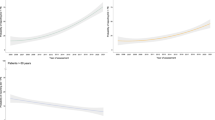Abstract
The aim of this study was to analyze characteristics of patients with Peyronie's disease (PD) diagnosed during a standart evaluation for erectile dysfunction (ED) and compare them with patients presenting with the classical complaints of PD. During a 10-y period, a total of 448 patients were evaluated at our two outpatient clinics, directed by the same author (AK). They were divided into two groups: group I consisted of patients, who presented with only ED and were unaware of their penile deformity, and group II consisted of patients with the classical features of the disease. The clinical characteristics, penile deformities, erectile status and the presence of comorbidities were determined in the two groups. Of 448 Peyronie's patients, 16% (n=71) were detected during diagnostic work-up for ED. In this group of patients, ED was the presenting symptom for a mean period of 31.3±9.7 months. The mean age of men was 57.54±8.75 and 52.21±10.27 y in groups I and II, respectively (P=0.0001). The mean degree of deformity was 31.5±12.66° in group I and 41.16±19.14° in group II (P=0.0001). In group I (n=71), 69% (n=49) of the patients had a poor erectile response to the combined injection and stimulation (CIS) test. Also, in this group, the mean degrees of deformity in CIS-positive and -negative patients were 27.05±12.50 and 33.80±12.03°, respectively (P=0.033). Diabetes mellitus (40%) was the leading comorbidity in group I, while at least one comorbidity was observed in 73% of the cases (P=0.001). A remarkable percent of Peyronie's patients (16%) were detected during a standard evaluation for ED. This study analyzed, for the first time, the frequency and the characteristics of incidentally diagnosed Peyronie's patients who presented with only ED. Our data indicate that one should always consider the possibility of PD in older patients with diabetes, presenting with only ED.
This is a preview of subscription content, access via your institution
Access options
Subscribe to this journal
Receive 8 print issues and online access
$259.00 per year
only $32.38 per issue
Buy this article
- Purchase on Springer Link
- Instant access to full article PDF
Prices may be subject to local taxes which are calculated during checkout
Similar content being viewed by others
References
Brock G et al. The anatomy of the tunica albuginea in the normal penis and Peyronie's disease. J Urol 1997; 157: 276–281.
Smith BH . Peyronie's disease. Am J Clin Pathol 1966; 45: 670–678.
La Pera G et al. SIMONA Study Group. Peyronie's disease: prevalence and association with cigarette smoking. A multicenter population-based study in men aged 50–69 years. Eur Urol 2001; 40: 525–530.
Sommer F et al. Epidemiology of Peyronie's disease. Int J Impot Res 2002; 14: 379–383.
Lindsay MB et al. The incidence of Peyronie's disease in Rochester, Minnesota, 1950 through 1984. J Urol 1991; 146: 1007–1009.
Jarow JP, Lowe FC . Penile trauma: an etiologic factor in Peyronie's disease and erectile dysfunction. J Urol 1997; 158: 1388–1390.
Devine CJ, Somers KD, Jordan GH, Shlossberg SM . Proposal: trauma as the cause of the Peyronie's lesion. J Urol 1997; 157: 285–290.
Weidner W, Schroder Prıntzen I, Weiske WH, Vosshenrich R . Sexual dysfunction in Peyronie's disease: an analysis of 222 patients without previous local plaque therapy. J Urol 1997; 157: 325–328.
Lopez JA, Jarow JP . Penile vascular evaluation of men with Peyronie's disease. J Urol 1993; 149: 53–55.
Furlow WL, Swenson Jr HE, Lee RE . Peyronie's disease: a study of its natural history and treatment with orthovoltage radiotherapy. J Urol 1975; 114: 69–71.
Stecker Jr JF, Devine Jr CJ . Evaluation of erectile dysfunction in patients with Peyronie's disease. J Urol 1984; 132: 680–681.
Jordan GH, Angermeier KW . Preoperative evaluation of erectile function with dynamic infusion cavernosometry/cavernosography in patients undergoing surgery for Peyronie's disease: correlation with postoperative results. J Urol 1993; 150: 1138–1142.
Levine AL, Coogan CL . Penile vascular assessment using color Duplex sonograhy in men with Peyronie's disease. J Urol 1996; 155: 1270–1273.
Kadioglu A et al. Color Doppler ultrasound assessment of penile vascular system in men with Peyronie's disease. Int J Impot Res 2000; 12: 263–267.
Montorsi F et al. Vascular abnormalities in Peyronie's disease : the role of color Doppler sonography. J Urol 1996; 151: 373–375.
Hellstrom WJG, Bivalacqua T . Peyronie's disease: etiology, medical and surgical therapy—review. J Androl 2000; 21: 347–354.
Lue TF . Physiology of penile erection and pathophysiology of erectile dysfunction and priapism. In: Walsh PC, Retik AB, Vaughan ED, Wein AJ (eds). Campbell's Urology, 8th edn. Saunders: Philadelphia, 2002, pp 1591–1618.
Chilton CP, Westwood WM, Pryor JP . Factors associated in the etiology of Peyronie's disease. Br J Urol 1982; 54: 748–750.
Carrieri MP et al. A case control study on risk factors for Peyronie's disease. J Clin Epidemiol 1998; 51: 511–515.
Levine AL, Latchamsetty KC . Treatment of erectile dysfunction in patients with Peyronie's disease using sildenafil citrate. Int J Impot Res 2002; 14: 478–482.
Author information
Authors and Affiliations
Corresponding author
Rights and permissions
About this article
Cite this article
Kadioglu, A., Oktar, T., Kandirali, E. et al. Incidentally diagnosed Peyronie's disease in men presenting with erectile dysfuntion. Int J Impot Res 16, 540–543 (2004). https://doi.org/10.1038/sj.ijir.3901247
Received:
Revised:
Accepted:
Published:
Issue Date:
DOI: https://doi.org/10.1038/sj.ijir.3901247
Keywords
This article is cited by
-
Trends in treatment of Peyronie’s disease in adult men in the United States from 2008 to 2017—results from an encounter and claims database
International Journal of Impotence Research (2022)
-
Comparison of clinician and patient users of a mobile phone application to assess penile curvature in Peyronie’s disease
International Journal of Impotence Research (2020)
-
The direction and severity of penile curvature does not have an impact on concomitant vasculogenic erectile dysfunction in patients with Peyronie’s disease
International Journal of Impotence Research (2015)
-
How curved is too curved? The severity of penile deformity may predict sexual disability among men with Peyronie’s disease
International Journal of Impotence Research (2013)
-
Krummer Penis macht Sex zur Qual
MMW - Fortschritte der Medizin (2012)


